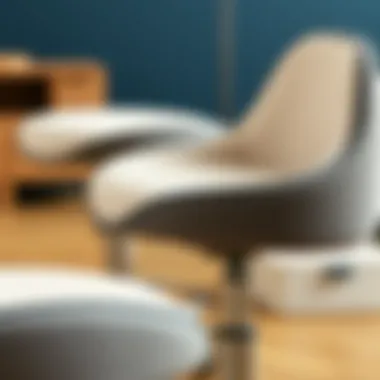Exploring Adjustable Swivel Stools with Back: Overview


Intro
In today's fast-paced world, where flexibility and comfort reign supreme, the adjustable swivel stool with back has emerged as a favorite piece of furniture in various settings. Whether it graces a kitchen island, a home office desk, or a stylish bar, this stool offers an incredible blend of aesthetics and functionality. It’s not just about style; it’s about enhancing the user experience and fitting seamlessly into diverse environments.
For homeowners and interior designers alike, understanding the nuances of these stools is vital. From their design elements to their ergonomic advantages, they're much more than mere seating options. Over the course of this article, we will explore the breadth of adjustable swivel stools with backs, shedding light on their design inspirations, practical advice for maintenance, and smart space planning solutions.
Whether you're looking to spruce up your living space or simply aiming to find the perfect seating solution, this comprehensive overview aims to inform and inspire. Let’s dive into the key aspects that make adjustable swivel stools an essential addition to modern interiors.
Design Inspiration
Trending Furniture Styles
As we explore the adjustable swivel stool with back, it's essential to look at the design inspirations that fuel trends in furniture. The popularity of these stools is often driven by the overarching styles in interior design.
- Mid-Century Modern: Characterized by clean lines and organic curves, these stools often feature wooden elements paired with retro hues. The emphasis on functionality makes them a favorite for eclectic spaces.
- Industrial Chic: With the use of metal frames and minimalist designs, adjustable swivel stools in this style usually add a rugged flair. They fit beautifully in lofts or modern urban settings.
- Scandinavia Minimalism: Here, the stools embody simplicity and elegance. Light woods mixed with light fabric are common, making them a charming addition to any neutral palette.
These styles influence how adjustable swivel stools not only function in a space but how they can tie the room together seamlessly.
Color Palettes and Combinations
The color of an adjustable swivel stool can dramatically transform the ambiance of a room. The right combination can enhance other design elements, creating harmony. Some popular choices include:
- Bold Primary Colors: Red, blue, and yellow can create lively focal points, particularly in vibrant kitchens or playrooms.
- Muted Earth Tones: Olive green, burnt orange, and sandy beige often lend a calming effect, perfect for creating cozy spaces.
- Pastel Shades: Soft pinks, blues, and mint green can introduce a playful touch, adding a contemporary feel especially in light and airy environments.
Thoroughly comprehending these aspects allows for thoughtful selections that extend beyond mere functionality.
"The design of a stool speaks volumes about the taste and aesthetic choices of the homeowner. An adjustable swivel stool with a back is not just a seat; it is a statement piece that can elevate a room's character."
Having a keen eye on design inspirations can lay the groundwork for better choices in your home settings, and equip designers with the necessary insights to cater to varied client demands. As we move forward, let’s shift focus onto practical advice that every homeowner and designer should keep in mind.
Practical Advice
Furniture Maintenance Tips
Keeping your adjustable swivel stool in tip-top shape is simpler than you might think. Here are some handy maintenance tips:
- Regular Cleaning: Use a soft cloth and a gentle cleaning solution to wipe down surfaces regularly, preventing dust accumulation.
- Inspect Mechanisms: It's good practice to check the swivel and height adjustment mechanisms periodically. A little lubrication can keep them functioning smoothly.
- Protect Finishes: For wooden stools, consider using coasters under drinks to avoid stains, and apply wood polish occasionally to maintain their luster.
Space Planning Solutions
When it comes to planning your space, adjustable swivel stools are immensely versatile. They are particularly useful where space is at a premium or when you need flexibility:
- Multipurpose Areas: They can be easily tucked under counters or tables, making them an ideal choice for spaces that serve multiple purposes.
- Adjustable Heights: This feature allows them to fit in various locations, whether for dining, working, or casual gatherings.
- Size Matters: Opt for stools that match the scale of your space. Too bulky can cause crowding, while too small may lack presence.
Understanding how to care for your stools and where to place them will extend their life and enhance the usability of your home.
As we wrap this section up, combining thoughtful design inspirations with practical advice will not only ensure that your adjustable swivel stools look good but also stand the test of time.
Understanding Adjustable Swivel Stools
Adjustable swivel stools with backs are not just stylish pieces of furniture; they play a significant role in enhancing comfort and functionality in various settings. These stools are particularly versatile, seamlessly fitting into both home and professional environments, where accommodating different heights and preferences can elevate the overall experience.
Definition and Key Features
An adjustable swivel stool, as the name suggests, allows the user to adjust the height of the seat to suit individual needs. The swivel function enables easy rotation, facilitating ease of movement without requiring the user to stand up. This is particularly useful in spaces where multitasking is essential, such as kitchens, bars, and studios.
Key features of these stools often include:
- Height Adjustability: Most models use a pneumatic lift mechanism, which allows quick and easy adjustments.
- Swivel Capability: This feature grants freedom of movement, ideal for busy environments.
- Backrest Support: The presence of a backrest provides necessary support, promoting better posture and reducing fatigue during extended use.
- Durable Materials: Quality adjustable swivel stools are often made from robust materials like metal, wood, or high-grade plastics, ensuring longevity and durability.
"Choosing an adjustable swivel stool combines form and function, presenting an option that adapts to the user rather than the opposite."
Design Variations and Aesthetics
The aesthetic appeal of adjustable swivel stools is substantial, with numerous design variations available to cater to different tastes and interior styles. From minimalist designs that blend into contemporary spaces to more ornate styles that can serve as a statement piece, there is no shortage of designs to choose from.
esign variations can include:


- Materials: Options range from leather and fabric seats to wooden stools or metal frames, creating a range of visual appeals.
- Colors and Finishes: Stools come in a myriad of colors and finishes, allowing them to either accentuate or blend into existing decor.
- Footrests and Base Styles: Some designs feature integrated footrests or unique base shapes, which not only add to the aesthetics but also enhance comfort.
Considering the overall decor will help ensure that the selected stool not only serves its functional purpose but also contributes positively to the visual narrative of the space.
The Importance of Backs in Stool Design
When it comes to designing and choosing stools for various spaces, the backrest is a key player that shouldn't be overlooked. Stools with backs provide a unique blend of comfort and support that enhances their usability across different environments. This discussion will delve into the importance of backs in stool design, focusing on ergonomic benefits, practical considerations, and aesthetic appeal.
Ergonomic Benefits of Having a Backrest
In an age where sitting for extended periods has become the norm, the ergonomic advantages of having a backrest are paramount. A well-designed backrest offers crucial lumbar support, which can help prevent lower back pain—a common ailment among office workers, bartenders, or anyone spending long hours seated.
- Posture Support: With a backrest, the spine can maintain its natural curve. Good posture can alleviate tension in the neck and shoulders, keeping alignments in check.
- Comfort Level: Stools equipped with backs allow users to lean back comfortably. This slight recline can take the pressure off the legs, promoting blood flow and reducing fatigue during prolonged usage.
- Increased Stability: A backrest also helps in maintaining a stable sitting position, particularly useful in settings that require movement, like kitchens and cafes.
*Investing in stools with proper back support is not merely about aesthetics; it can be a cornerstone of a healthier workspace or home environment."
Contrast Between Backed and Backless Stools
Backed versus backless stools can stir quite the debate among designers and homeowners. Each type carries its own set of pros and cons, yet the choice often hinges on personal preference and the intended usage.
- Space Implications: Backless stools have a more minimalistic silhouette, which can be perfect for small spaces. However, they generally provide less support, making them less suitable for long-term sitting.
- Versatility: Backless stools often allow for easier mobility, as they can be tucked under counters or tables without obstructing movement. However, this versatility can come at the cost of comfort during long sittings.
- Aesthetic Appeal: Backed stools usually bring a sense of elegance and comfort to a room, making them an excellent match for dining areas and professional settings. Meanwhile, backless stools suit casual, laid-back environments such as bars where a quick drink is the primary focus rather than lingering at the table.
Materials Utilized in Adjustable Swivel Stools
The materials used in adjustable swivel stools play a pivotal role in determining their functionality, durability, and aesthetics. Choosing the right materials affects not only the physical characteristics of the stool but also influences the user’s experience and the overall look of the space. Homeowners and designers must consider the properties of various materials as well as their suitability for different environments.
Common Materials and Their Properties
When it comes to adjustable swivel stools, a variety of materials can be found, each with its unique advantages and drawbacks. Here are some common options:
- Wood: Often chosen for its timeless appeal, wooden stools provide warmth and elegance. Hardwoods like oak and maple offer durability, while softer woods such as pine can be more affordable but may not withstand heavy use as well. Wood finishes also allow for a range of colors and styles, from rustic to modern.
- Metal: Stainless steel, aluminum, and powder-coated metals are popular for their strength and resistance to corrosion. Metal stools tend to have a more industrial look and are often used in commercial settings. They are easy to clean, making them suitable for both homes and busy cafes.
- Plastic: Lightweight and usually budget-friendly, plastic stools come in an array of colors and designs. They are easy to move around and often stackable, which is a plus in smaller spaces. However, they might lack the longevity of wood or metal options and can be more prone to fading over time.
- Upholstered Materials: Many stools have cushioned seats covered with fabric, vinyl, or leather. Upholstered options provide extra comfort, especially when sitting for extended periods. While they can look stylish, upholstery requires regular cleaning and maintenance to remain in good shape.
Mixing and matching these materials can also yield attractive results, allowing for personalized designs to fit different styles and needs. The interplay of textures and colors can make a stool standout feature in any room.
Sustainability Considerations
In today’s world, sustainability has become more important than ever. When selecting materials for adjustable swivel stools, conscientious consumers and designers often turn their attention to environmental impact. Here are some sustainability aspects to think about:
- Material Sourcing: Opting for materials that are sustainably sourced or recycled can significantly reduce the environmental footprint of furniture. For example, reclaimed wood not only offers a unique aesthetic but also helps minimize deforestation.
- Manufacturing Processes: Understanding how the stool is made can also play a vital role in sustainability. Products that utilize eco-friendly manufacturing processes can help conserve energy and reduce waste.
- Longevity: Choosing durable materials leads to longer-lasting products, which reduces the need for frequent replacements. This is particularly relevant for stools used in high-traffic areas, where regular wear might necessitate new purchases more often.
In light of this, many companies now offer environmentally-friendly options. These might include cushioning materials made from recycled plastics or eco-conscious wood varieties. This trend is likely to continue, reflecting a growing demand for responsible practices in furniture design.
"The materials chosen for adjustable swivel stools directly impact not only their aesthetic but also their environmental footprint. Mindful choices can lead to both stylish and sustainable solutions."
As discussed, the materials used in adjustable swivel stools are critical in defining their style, comfort, and sustainability. By weighing the benefits of each against the specific needs and aesthetic goals of the space, homeowners and designers can make informed decisions that align with both functionality and environmental considerations.
Functional Applications of Adjustable Swivel Stools
Adjustable swivel stools serve as more than just an addition to a room; they bring versatility and functionality to various environments. Understanding their significance in practical settings elevates the notion of how seating can enhance everyday interactions and experiences. From cozy kitchens to bustling cafes, these tools adapt beautifully, catering to a myriad of functional needs while retaining aesthetic allure.
Home Use: Kitchens and Dining Areas
In many homes, the kitchen is often the heart of social interaction. An adjustable swivel stool fits seamlessly within this environment, offering a practical yet stylish seating choice. These stools can slide under counters without fuss, turning a compact space into an inviting gathering area. Imagine a situation where you are cooking, and family or friends want to join in. A swivel stool allows them to engage with you while keeping the conversation lively.
- Space Efficiency: When not in use, which can often be the case in a busy kitchen, these stools can be tucked away neatly. This helps maintain an uncluttered appearance, especially in smaller homes where space is at a premium.
- Ease of Movement: The ability to swivel enhances accessibility. Whether you’re preparing a meal or serving, it allows a swift spin to grab utensils or chat with someone nearby.
- Design Versatility: With various styles available, from sleek metal to warm wood finishes, they can complement any decor. A modern stool in chrome can contrast beautifully against rustic wooden meals, while a soft upholstered option creates a cozy vibe.
Professional Environments: Offices and Studios
In the hustle and bustle of professional settings, adjustable swivel stools have carved a niche for themselves. They provide a blend of comfort and functionality, especially in dynamic workspaces like studios and open-plan offices.
- Ergonomic Considerations: Many of these stools come designed with backs that support good posture. This consideration is especially pivotal when employees spend long hours sitting while working on tasks that require focus and creativity. A comfortable seating arrangement boosts productivity and concentration.
- Meeting Spaces: Adjustable stools can be a fantastic choice for informal meetings. Their height adjustability allows different people to find a comfortable position, helping to create an engaging environment where creativity can flourish.
- Flexibility: In creative studios, the ability to pivot can facilitate collaborative work. Multiple individuals can share ideas without feeling confined to a set arrangement, encouraging a workflow that feels dynamic and fluid.
Public Spaces: Cafes and Bars
Cafes and bars often thrive on their ambiance, and adjustable swivel stools contribute substantially to that atmosphere. They encourage social interaction, making them a staple in these public spaces.


- Social Hub: Swivel stools often attract patrons looking for a quick bite or a drink while engaging with friends or strangers. The mobility makes it easy to shift and mingle, enhancing the communal feel.
- Aesthetic Value: Bars and cafes utilize these stools to create a visual identity. An eclectic mix of designs can draw in a crowd, and pairing vibrant colors with rustic woods can really craft an inviting space.
- Service Efficiency: For bartenders and servers, the accessibility of customers seated on stools often means faster service. Since patrons can be swiftly turned for interaction or drink selection, it makes operations smoother.
"Adjustable swivel stools are more than just furniture; they are catalysts for social interaction and creative collaboration."
In essence, the functional applications of adjustable swivel stools are vast and varied, each fulfilling distinct needs across different areas of life. Their ability to blend functionality with aesthetic appeal makes them a wise choice for any space, enhancing both daily activities and spontaneous encounters.
Selecting the Right Stool: Factors to Consider
Choosing an adjustable swivel stool with a back involves more than just picking a pretty seat. There are a multitude of elements that impact both functionality and comfort. Understanding these factors can make a world of difference in your experience, especially if you intend to use the stool for extended periods. A well-selected stool not only complements the surrounding decor but also offers ergonomic support, making it crucial for homeowners, designers, and decorators to take these aspects into account.
Height Adjustability and Range
The first aspect you should think about is height adjustability. It’s one of those things that seems simple but makes a big impact. Consider how tall you are or how tall your kitchen counter or desk is. Most adjustable stools will have varying height ranges, typically from about 18 inches to 30 inches, or sometimes even more. If your stool doesn't adjust properly, you're left perched, struggling to reach your workspace, or hunching over, which isn't good for your back.
Some stools offer pneumatic height adjustments, which allow for smooth and effortless changes, while others may employ a screw mechanism, which might be a bit clunkier.
- Pros of Height Adjustability:
- Tailors the stool to your needs.
- Makes the stool versatile for different tasks.
- Beneficial for multi-user environments, like restaurants or home kitchens.
Before making a purchase, determine what adjustment method best suits your routine. A stool that won't adjust to fit the space properly can quickly become a thorn in your side, literally and figuratively.
Weight Capacity and Stability
Next up: weight capacity and stability. Many folks overlook this aspect but choosing a stool that can adequately support the intended users is essential. Each stool comes with a weight limit—usually somewhere between 200 to 400 pounds. If you push beyond these limits, you risk damaging the stool or worse, causing it to collapse under pressure.
Equally important is stability. A sturdy base, often constructed from cast iron or heavy-duty plastic, helps prevent tips and wobbles. If you’re using the stool in a busy cafe or a bustling kitchen, stability can be the difference between a tranquil time and a precarious situation.
When assessing stability, consider these factors:
- Base Design: A wide base enhances steadiness.
- Materials Used: Durable, heavy materials add to stability.
- Legs Configuration: Four legs generally offer better balance than three.
Selecting a stool that provides both proper weight capacity and stability can give you peace of mind while you work or relax.
Design Compatibility with Existing Decor
Last but not least, we can’t forget about design compatibility. The stool must blend in harmoniously with the surrounding environment. Whether your home sports a modern chic vibe or a rustic vintage charm, choosing colors, materials, and styles that align with existing furnishings is paramount.
You might think that all stools are created equal, but you'll be surprised by how much variety there is. From leather finishes to sleek metal frames, the aesthetic choices are nearly endless. Here are some points to ponder:
- Color and Material Choices: A leather stool will convey luxury, while a wooden one can reaffirm a cozy, homely feel.
- Shape and Silhouette: Rounded stools can soften harsh lines in a modern kitchen, while angular designs add a touch of sophistication.
- Finish Style: Matte vs. glossy can also impact the overall perception of the space.
"The right adjustable swivel stool can become not just a piece of furniture, but a statement in your overall design palette."
In short, take your time scouting for a stool that not only serves its purpose but also enriches your decor. The right stool can elevate the visual appeal of a space while maintaining practicality.
Being mindful of height adjustability, weight capacity, and design compatibility will set you on the right path to making an informed choice. So, next time you’re about to click ‘buy,’ put these factors under the spotlight—they might just lead you to the perfect stool.
Maintenance and Care for Longevity
Taking good care of your adjustable swivel stool with a back is crucial for ensuring its longevity and maximizing its functionality. Regular maintenance not only keeps your stool looking fresh and appealing but also prevents issues that may arise over time, such as structural weaknesses or worn-out upholstery. Proper care can save you money in the long run, ensuring that your investment remains both practical and aesthetically pleasing.
Cleaning Techniques Based on Materials
The cleaning method required will largely depend on the material used to construct your stool. Here are some insights on how to tackle different surfaces:
- Leather or Faux Leather: Wipe down with a damp cloth to remove dust and spills. For deeper cleaning, use a leather cleaner, ensuring to follow the manufacturer's instructions. Avoid soaking the material, as this can lead to damage.
- Fabric Upholstery: A vacuum with a brush attachment is your best friend here. For stains, using a fabric cleaner is effective—test on a hidden area first to ensure it doesn't discolor the fabric.
- Metal Frames: Use a soft, damp cloth to remove fingerprints and smudges. Avoid abrasive cleaners which could scratch the surface. A mix of mild soap and water can be used to tackle stubborn patches.
- Wood Finishes: Dust regularly with a dry cloth and occasionally polish with a wood-safe cleaner. Keep away from direct sunlight to prevent fading.
Preventative Maintenance Practices
Being proactive about maintenance can extend the life of your adjustable swivel stool significantly. Here are some practices to consider:
- Regular Inspection: Check the screws and bolts periodically to ensure they are tight and secure. Loose hardware can lead to instability.
- Rotate the Stool: If your stool is frequently used, try to rotate it around a bit. This distributes wear evenly and can prevent any one area from becoming too worn.
- Avoid Overloading: Always adhere to the manufacturer’s weight recommendations. Excess weight can compromise the frame and the mechanics of the swivel feature.
- Dust and Debris: Prevent build-up of dust and other particles that can scratch surfaces or get stuck in the mechanism. A weekly quick wipe-down can make a big difference.
- Protective Pads: Use felt pads under the legs if your stool is on hardwood floors to avoid scratches or scuff marks. This simple measure goes a long way in preserving both your stool and your floor.
"An ounce of prevention is worth a pound of cure."


By integrating these maintenance routines into your care practices, you can ensure that your swivel stool remains an integral and attractive part of your space for years to come. Keeping it clean and secure is an investment in comfort and style that pays off in the long run.
The Historical Context of Stool Design
The historical context of stool design is pivotal to understanding the evolution and significance of adjustable swivel stools with backs. From humble beginnings to sophisticated designs, the journey of stools reflects broader societal changes. This section dives into how seating practices have transformed, influenced by needs, materials, and aesthetics. The history of stools not only informs their functionality but also their role in public and private spaces, showcasing how our interactions with furniture have changed through the ages.
Evolution of Seating Practices
Seating has long been a necessity in human life, evolving from simple stone and log formations to more refined and functional pieces like the adjustable swivel stool. In ancient Egypt, for instance, stools were made from wood or metal and often adorned with intricate carvings, serving both practical and ceremonial purposes. Fast forward a few centuries, and you find that the Industrial Revolution drastically shifted seating designs. The introduction of mass manufacturing allowed stools to be produced in bulk, making them more accessible to the average person.
Adjustable swivel stools find their roots in the needs of varied environments, whether it was the rise of cafes in Paris or the bustling atmosphere of workshops. As people began valuing convenience and flexibility, the design of stools adapted; the traditional fixed height evolved into a system that allowed users to modify their sitting position according to their needs. Today, whether in a bustling kitchen or a professional office, the adjustable swivel stool brings forth an aspect of adaptability that meets the fast-paced lifestyle of modern society.
Influential Design Movements
Various design movements have played an instrumental role in shaping how we perceive and utilize stools, particularly those with a modern twist like the adjustable swivel type.
- Arts and Crafts Movement: In the late 19th century, this movement emphasized craftsmanship and functional design, inspiring furniture makers to create pieces that combined beauty with practicality. The robust construction of stools from this era often featured natural materials and simple forms that carried through to later designs.
- Bauhaus Movement: The 20th century saw the emergence of the Bauhaus movement, advocating for functional design devoid of ornamentation. This philosophy influenced stool designs significantly, even leading to innovative materials like tubular steel and vinyl upholstery. These elements are prevalent in many contemporary adjustable stools, merging form with functionality.
- Mid-Century Modern Design: The mid-20th century introduced a wave of innovative designs, pushing boundaries in both aesthetics and comfort. Designers began experimenting with new shapes and materials, producing iconic stools that are both stylish and ergonomic. This period showcased the importance of integrating the form with the environment, leading to the creation of adjustable models that seamlessly blend into diverse interiors.
Understanding these movements helps homeowners, designers, and decorators appreciate the cultural significance of their chosen stools, elevating them beyond mere functional objects to pieces of art that reflect history.
"The design of a stool can be a reflection of societal needs, illustrating how we engage with our environments through the lens of seating."
Current Trends in Adjustable Swivel Stools
In today's fast-paced world, the adjustable swivel stool with a back is becoming a popular choice for many settings, from homes to professional spaces. Understanding the current trends in these stools is essential for homeowners, interior designers, and decorators alike. These trends align closely with advancing concepts of ergonomics, aesthetic flexibility, and functionality. They reflect a growing recognition of how seating impacts both comfort and productivity.
Popular Design Elements in Modern Styles
Modern adjustable swivel stools are no longer just functional objects; they have transformed into integral elements of contemporary interior design. Key trends include:
- Sleek Lines and Minimalist Forms: Many contemporary designs favor simplicity. Clean lines and a minimalistic approach allow these stools to fit seamlessly into various decor styles, from industrial to Scandinavian.
- Bold Colors and Unique Textures: Designers are playing with vibrant colors and textures, pushing the boundaries of traditional stool designs. High-contrast colors or cushioned backs with different fabrics can create eye-catching focal points in kitchens or studios.
- Mixed Materials: Combining wood, metal, and upholstery is fashionable. For instance, a wooden seat atop a steel base can add depth and enhance visual appeal.
- Integrated Technology: Some modern stools incorporate technology, allowing for adjustments at the push of a button or features like built-in charging ports. Such innovations cater to tech-savvy users who appreciate functional convenience.
This diverse range of features and styles empowers consumers to select stools that match their personal taste and functional needs, ultimately enriching their living or working spaces.
Rising Demand for Customization
There's a clear trend stirring in the market—personalization. People are not just looking for chairs; they want ones that resonate with their individual style. The rising demand for customization in adjustable swivel stools speaks volumes about contemporary consumer behavior:
- Made-to-Order Options: Many manufacturers are now offering made-to-order stools, allowing customers to choose colors, materials, and finishes. This can result in a stool that complements existing decor perfectly.
- Adjustable Features: Beyond height, customization includes backrest angles, seat depth, and even pivoting mechanisms, tailoring the stool experience to individual needs.
- Personalized Branding: In commercial settings, businesses are using customizable stools featuring their logos or color schemes, further merging functionality with branding.
- DIY Kits: Some enthusiasts are taking matters into their own hands, with kits that allow for personal assembly and design decisions.
By embracing customization, both manufacturers and consumers are redefining the adjustable swivel stool from a simple piece of furniture to a unique piece, fundamentally changing how we approach seating in various environments.
As these trends evolve, they highlight a shift towards a more personalized, aesthetic-driven seating choice that meets the practical needs of everyday life.
"The future of furniture design is not just about aesthetics; it's a blend of comfort, style, and personal expression."
For more insight into design trends, you can refer to resources like Wikipedia and Britannica.
As you explore these trends, consider how they fit into your own spaces or projects. The right adjustable swivel stool could be just what you need to enhance both functionality and style.
Culmination: The Future of Adjustable Swivel Stools
The adjustable swivel stool with back is poised to see significant advancements, reflecting changes in both taste and functionality. As the design evolves, several key factors will guide this transformation. First and foremost is the growing emphasis on ergonomic support. With increasing awareness of health and comfort, future models are expected to feature enhanced lumbar support and adaptable backrest designs tailored to individual preferences. This trend is not just a response to consumer demand but a recognition of the pivotal role good posture plays in everyday well-being.
Anticipated Innovations in Design and Function
Innovations in technology are likely to revolutionize how we perceive these stools. The integration of smart features, such as adjustable height mechanisms that can remember settings based on user profiles, could be on the horizon. Imagine a stool that adjusts to your preferred sitting position even before you take a seat. Moreover, materials with built-in temperature regulation or odor control might emerge, enhancing the overall user experience.
Another area to consider is sustainability. As consumers continue to become eco-conscious, manufacturers may move toward biodegradable and recyclable materials. Envision stools crafted from reclaimed wood or metal, seamlessly combining durability with environmental stewardship.
Furthermore, aesthetics are expected to take center stage. Bold colors and textures will enter the fray, permitting users to choose stools that resonate with their personal design preferences. Instead of blending into the background, the adjustable swivel stool could become a statement piece in any room, from contemporary kitchens to creative studios.
"The future lies not in what we have done, but in what we are yet to explore in design innovations."
Final Thoughts on Practicality and Aesthetics
In bringing together practicality and aesthetics, adjustable swivel stools with backs have already established their value across various settings. As our lifestyles evolve, these stools will need to adapt; their future lies in harmonizing form and function. The importance of style cannot be overstated, as homeowners and designers seek pieces that are not just functional but also elevate the space's overall vibe.
When selecting a stool, affordability will likely hinge on its adaptability, durability, and design—qualities that will dominate there construction. The blend of contemporary designs with traditional craftsmanship could strike a balance between modernity and timeless appeal.
Ultimately, the future of adjustable swivel stools with backs is bright, with endless possibilities on the horizon. With evolving expectations from consumers regarding comfort, sustainable materials, and stylish designs, these stools are set to occupy even more influential positions in our homes and workplaces alike. Keep an eye on where these innovations lead; the journey is just beginning.



